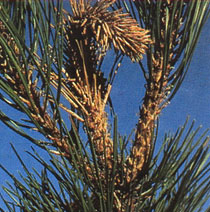
A well-trained arborist can identify and effectively treat the Insect & Disease problems. There are many conditions caused by insects or Diseases in trees. A Bode Tree Care certified arborist can advise you about prevalent insect infestation and disease infected areas and the effective course of treatment for each.
Complete
Insects Management Programs
These moths will create new shoots mostly on Ponderosa, Austrian, Scotch, and Jack Pine trees.
Larvae vary from yellowish-white to pink to reddish-orange, with dark heads. Mature Nantucket and Western Pine Tip moth larvae are 9 to 12 mm long; mature southwestern pine tip moth larvae are 12 to 15 mm long. Coloration and wingspan of the moths varies with the species; however, most are a mottled reddish-brown and gray.
Nantucket pine tip moths live over winter as pupae in the buds, while the other tip moths live over winter as pupae in the ground. Moths appear during spring and females lay eggs on new growth. Nantucket pine tree moths have 2 to 4+ generations per year. Western pine tip moths have 1 to 2+ generations per year. Southwestern pine tip moths have one generation per year.
Larave mine needles, buds, and new shoots, killing shoots and stunting tree growth. Old infested tips crumble when squeezed. Shoots infested with southwestern pine tip moths commonly turn brown and bend over in a shepherd’s crook.
western pine tip moth larva

southwestern pine tip moth damage

Photos courtesy of The Nebraska Forest Service –
Nebraska University www.nfs.unl.edu
Tree insect problems
Pine Tip Moth
Eric Bode
Certified Arborist IL-4572A
Contact
Bode Tree Care
Today for an estimate

Bode Tree Care
P.O. Box 612 Barrington, IL 60011
eric@bodetreecare.com p: 847-909-2100 f: 847-381-7350